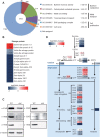shrunken4 is a mutant allele of ZmYSL2 that affects aleurone development and starch synthesis in maize
- PMID: 34009311
- PMCID: PMC8225342
- DOI: 10.1093/genetics/iyab070
shrunken4 is a mutant allele of ZmYSL2 that affects aleurone development and starch synthesis in maize
Abstract
Minerals are stored in the aleurone layer and embryo during maize seed development, but how they affect endosperm development and activity is unclear. Here, we cloned the gene underlying the classic maize kernel mutant shrunken4 (sh4) and found that it encodes the YELLOW STRIPE-LIKE oligopeptide metal transporter ZmYSL2. sh4 kernels had a shrunken phenotype with developmental defects in the aleurone layer and starchy endosperm cells. ZmYSL2 showed iron and zinc transporter activity in Xenopus laevis oocytes. Analysis using a specific antibody indicated that ZmYSL2 predominately accumulated in the aleurone and sub-aleurone layers in endosperm and the scutellum in embryos. Specific iron deposition was observed in the aleurone layer in wild-type kernels. In sh4, however, the outermost monolayer of endosperm cells failed to accumulate iron and lost aleurone cell characteristics, indicating that proper functioning of ZmYSL2 and iron accumulation are essential for aleurone cell development. Transcriptome analysis of sh4 endosperm revealed that loss of ZmYSL2 function affects the expression of genes involved in starch synthesis and degradation processes, which is consistent with the delayed development and premature degradation of starch grains in sh4 kernels. Therefore, ZmYSL2 is critical for aleurone cell development and starchy endosperm cell activity during maize seed development.
Keywords: aleurone; iron transporter; maize; seed development; starch synthesis.
© The Author(s) 2021. Published by Oxford University Press on behalf of Genetics Society of America. All rights reserved. For permissions, please email: journals.permissions@oup.com.
Figures








Similar articles
-
The aleurone layer of cereal grains: Development, genetic regulation, and breeding applications.Plant Commun. 2025 Apr 14;6(4):101283. doi: 10.1016/j.xplc.2025.101283. Epub 2025 Feb 12. Plant Commun. 2025. PMID: 39949062 Free PMC article. Review.
-
Maize YSL2 is required for iron distribution and development in kernels.J Exp Bot. 2020 Oct 7;71(19):5896-5910. doi: 10.1093/jxb/eraa332. J Exp Bot. 2020. PMID: 32687576
-
ZmDof3, a maize endosperm-specific Dof protein gene, regulates starch accumulation and aleurone development in maize endosperm.Plant Mol Biol. 2017 Jan;93(1-2):7-20. doi: 10.1007/s11103-016-0543-y. Epub 2016 Oct 5. Plant Mol Biol. 2017. PMID: 27709320
-
The thick aleurone1 mutant defines a negative regulation of maize aleurone cell fate that functions downstream of defective kernel1.Plant Physiol. 2011 Aug;156(4):1826-36. doi: 10.1104/pp.111.177725. Epub 2011 May 26. Plant Physiol. 2011. PMID: 21617032 Free PMC article.
-
Protein accumulation in aleurone cells, sub-aleurone cells and the center starch endosperm of cereals.Plant Cell Rep. 2014 Oct;33(10):1607-15. doi: 10.1007/s00299-014-1651-2. Epub 2014 Jul 15. Plant Cell Rep. 2014. PMID: 25023874 Review.
Cited by
-
The transcription factors ZmNAC128 and ZmNAC130 coordinate with Opaque2 to promote endosperm filling in maize.Plant Cell. 2023 Oct 30;35(11):4066-4090. doi: 10.1093/plcell/koad215. Plant Cell. 2023. PMID: 37542515 Free PMC article.
-
A genome-wide association study identifies a transporter for zinc uploading to maize kernels.EMBO Rep. 2023 Jan 9;24(1):e55542. doi: 10.15252/embr.202255542. Epub 2022 Nov 17. EMBO Rep. 2023. PMID: 36394374 Free PMC article.
-
Maize Endosperm Development: Tissues, Cells, Molecular Regulation and Grain Quality Improvement.Front Plant Sci. 2022 Mar 7;13:852082. doi: 10.3389/fpls.2022.852082. eCollection 2022. Front Plant Sci. 2022. PMID: 35330868 Free PMC article. Review.
-
Maize kernel nutritional quality-an old challenge for modern breeders.Planta. 2025 Jan 25;261(2):43. doi: 10.1007/s00425-025-04627-y. Planta. 2025. PMID: 39856412 Review.
-
The aleurone layer of cereal grains: Development, genetic regulation, and breeding applications.Plant Commun. 2025 Apr 14;6(4):101283. doi: 10.1016/j.xplc.2025.101283. Epub 2025 Feb 12. Plant Commun. 2025. PMID: 39949062 Free PMC article. Review.
References
-
- Becraft PW, Asuncion-Crabb Y.. 2000. Positional cues specify and maintain aleurone cell fate in maize endosperm development. Development. 127:4039–4048. - PubMed
-
- Becraft PW, Li K, Dey N, Asuncion-Crabb Y.. 2002. The maize dek1 gene functions in embryonic pattern formation and cell fate specification. Development. 129:5217–5225. - PubMed
-
- Becraft PW, Stinard PS, McCarty DR.. 1996. CRINKLY4: A TNFR-like receptor kinase involved in maize epidermal differentiation. Science. 273:1406–1409. - PubMed
-
- Becraft PW, Yi G.. 2011. Regulation of aleurone development in cereal grains. J Exp Bot. 62:1669–1675. - PubMed
Publication types
MeSH terms
Substances
LinkOut - more resources
Full Text Sources
Other Literature Sources

